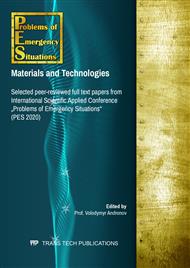p.3
p.11
p.19
p.25
p.32
p.41
p.47
p.55
Research of Fireproof Capability of Coating for Metal Constructions Using Calculation-Experimental Method
Abstract:
Determination of characteristic of fireproof capability of examined fire-retardant coating by experiment-calculated method solving the inverse heat conduction problems based on the firing tests data. With the aim of determining the fire-resistance time of metal sheets with fire-retardant coating there are used experimental research methods of patterns behavior during heating according to the requirements of National Standards of Ukraine B.V. 1.1.-4-98 are used; mathematical and computer modelling of processes of unsteady heat transfer in the system “metal sheet – fire-retardant coating”; determination of thermal characteristics and characteristic of coating fireproof capability. Firing tests of metal sheets covered by the flame retardant “Amotherm Steel Wb” are carried out. Based on the obtained data (temperature from the unheated sheet surface) there are determined the thermal characteristics of formed coating depending on temperature and the characteristic of fireproof capability of examined coating for 30 minutes fire-resistance time. The effectiveness of intumescent coating “Amotherm Steel Wb” is proved and the dependence between its heat conduction coefficient and temperature during heating in experimental stove of metal sheet with this coating in standard temperature conditions is specified. The co-relation between the thickness of intumescent coating “Amotherm Steel Wb” and fire-retarding quality of metal constructions is identified. Besides the necessary minimum thicknesses of such coating from the thickness of metal sheet for importance of 30 minutes fire-resistance time are calculated.
Info:
Periodical:
Pages:
3-10
Citation:
Online since:
August 2020
Price:
Сopyright:
© 2020 Trans Tech Publications Ltd. All Rights Reserved
Share:
Citation:


